I had the opportunity to visit the Denver Botanic Gardens last January on a day that was so cold, I thought I had flown to Alaska by mistake. I had pretty low expectations — what could I possibly expect to see at that time of year? Yet I came away both excited and inspired as I noticed all the creative ways the designers had added interest to the frozen landscape.
This wasn’t a case of a token clipped hedge or conifer to “provide structure.” These winter scenes were carefully orchestrated to be just that — scenes, not just fleeting moments. Each vignette had been deliberately staged to add depth and interest to the winter garden.
When we visit a large-scale public garden like this one, it is easy to dismiss it as being too vast to allow for reinterpretation in our home landscape. Yet I found that this garden offered many design tips that we can all learn from no matter how large or small our spaces.
Here are a few ideas to get you started.
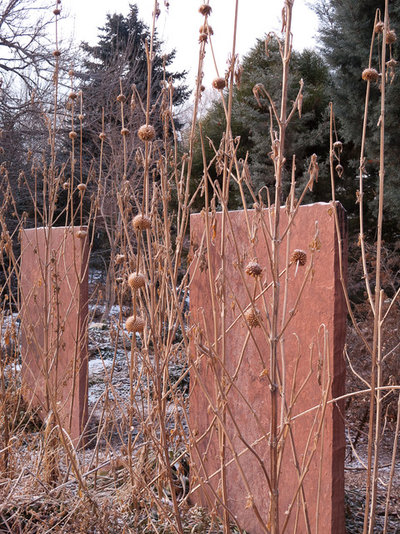
Le jardinet
Designing With Seed HeadsWe are often encouraged to leave some seed heads for the birds during the colder months, yet truthfully they are not always the most attractive design element in the winter garden.
1. Use a solid backdrop and repetition to create impact. Here a solution has been found: the creation of an attractive backdrop against which the seed heads are silhouetted.
Rather than a continuous fence, a series of discrete panels has been erected to define a boundary yet allow a glimpse of the garden beyond. Silhouetted against this are the tall dried stems and seed heads of
Lion’s Tail (
Leonotis sp).
The warm earth tones of both the panels and seed heads are welcome on gray days.
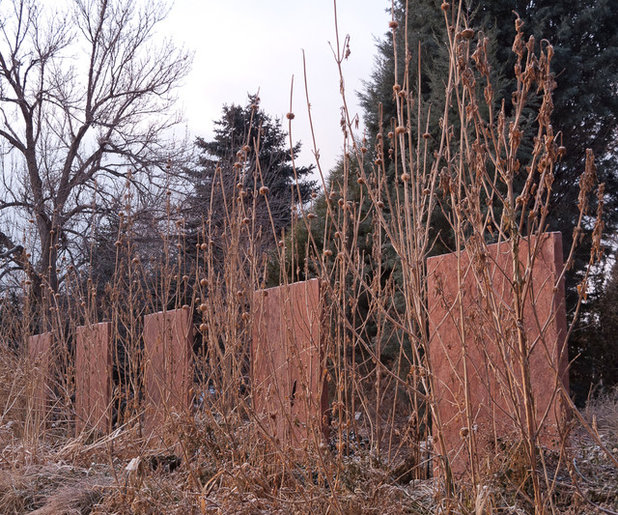
Le jardinet
The repetition of the fence panels and plantings sets up a rhythm that makes it clear that this is a planned design element — a single cluster might have appeared accidental and lost the impact.
Tip: Use a solid backdrop to silhouette your seed heads. Fences or evergreens work equally well, while the effect will be lost if you use wispy grasses or deciduous shrubs.
Rather than just a solitary clump of plants — for example, black-eyed Susan (
Rudbeckia sp) — consider adding at least two more groups at intervals around your garden; in larger gardens a single expansive swath can be dramatic.
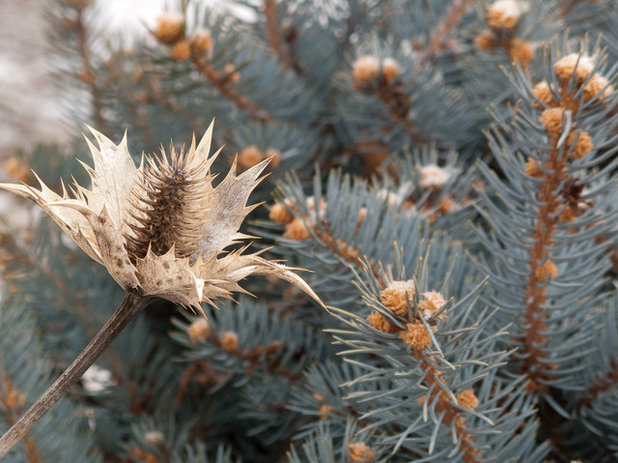
Le jardinet
2. Look for subtle ways to echo color. Summer brings an exciting kaleidoscope of color to the garden, with imaginative vignettes at every turn. Winter strips the garden down to bare bones, and as such we need to find creative ways to add interest.
This duo really caught my attention by doing just that. The spiky seed head in the foreground is
Sapphire Blue sea holly (
Eryngium ‘Sapphire Blue’). Its papery bracts are spread wide to reveal the teasel-like central cone. It is planted next to a dwarf form of Colorado blue spruce (
Picea pungens ‘Montgomery’).
I had never noticed the caramel-brown stems and buds on the spruce until I studied this combination. The tan seed head draws attention to this subtle detail by echoing the warm color, whereas usually my focus is on the powder-blue conifer and bold sea holly in their summer glory.
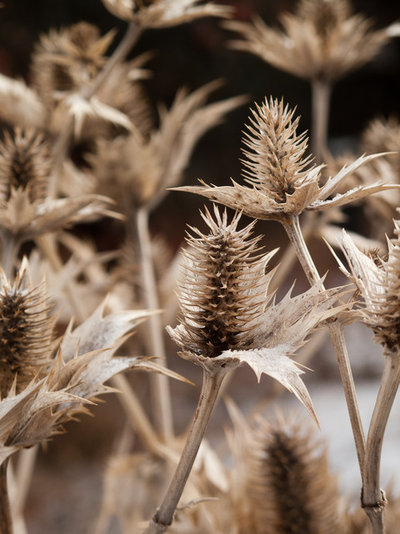
Le jardinet
Tip: We look for ways to combine flowers and foliage — take that a step further and look for ways to combine seed heads with foliage.
Cut samples of seed heads found in your garden and “audition” them in combination with other plants. Look for a pairing that brings focus to an otherwise missed detail, such as the color of a stem, berry or underside of a leaf.
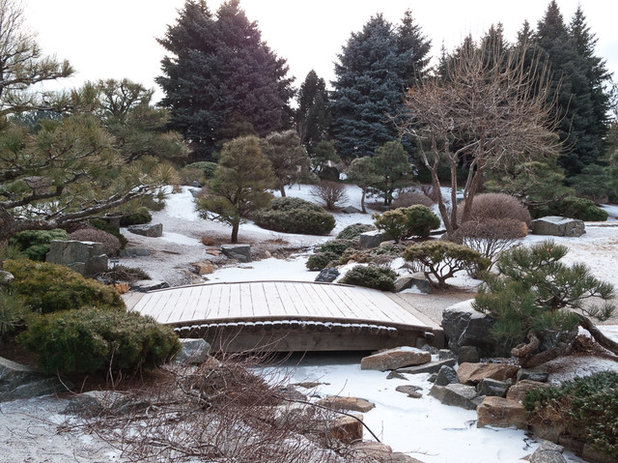
Le jardinet
Designing With ShapesJapanese gardens are often cited as being wonderful examples of designing with year-round interest in mind, and the one in Denver is no exception. Stepping through the entry gate, I found myself in a carefully crafted sculpture garden.
Conifers had been artistically pruned to reveal a contorted branching pattern or maintain a compact cushion of foliage. Several pines had been nurtured over many years to create cloud-like forms.
Looking across the garden, I could discern mounds, cones and more prostrate forms in the plant selection, the many boulders and the simple bridge spanning the dry creek. This variety of shapes is key to the success of the garden at least as much as the varied selection of evergreens.
Tip: As you look at your garden, what shapes do you see? One way to analyze this is to print out a black and white photograph and sketch on it. The Skitch mobile app makes this a quick exercise.
If there are too few clearly discernible shapes, look for suitable plants to fill the roles. For example, do you need a short, squat mound to break up the tall, columnar trees? Or perhaps your landscape seems all loose mounds, and a tight, conical shape would add interest? Sometimes the addition of carefully placed boulders can make all the difference.
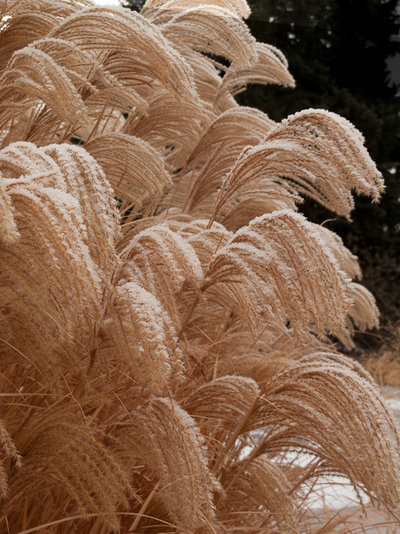
Le jardinet
Designing With GrassesOf all the photographs I took during my visit, this is perhaps my favorite. I think it is the counterpoint between the soft, feathery texture of the grasses and the ice they are encrusted with, frozen in time. It reminds me of a scene from Narnia.
Many herbaceous grasses will last through the winter. The dried blades will rustle in the breeze, add movement on a windy day and create a sculpture in winter as well as providing food and safety for many birds.
How can we use them in winter design? I gleaned several ideas from the Denver gardens.
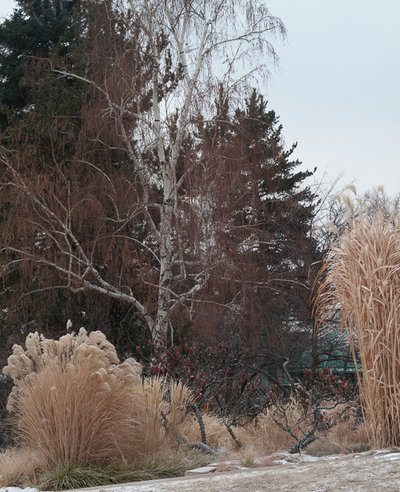
Le jardinet
1. Combine grasses with interesting deciduous trees and shrubs. Frozen grasses flank the widely branched silhouette of a sumac (
Rhus typhina)
decorated with deep red seed heads like forgotten Christmas decorations. The contrast between the vertical grasses and looser branching pattern is an easy design concept to copy.
Tip: Sumac is a thug in the garden, with a prolific suckering habit that is not for the faint of heart. So while I cannot recommend
that shrub, you could substitute a corkscrew hazelnut (
Corylus avellana ‘Contorta’) for its contorted silhouette and get a similar effect. If you use the cultivar Red Majestic, you will also get twisted red catkins.
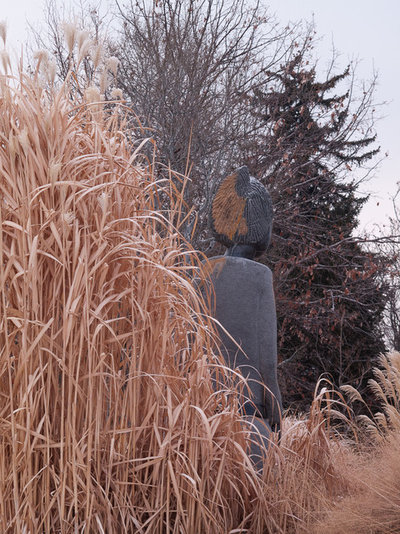
Le jardinet
2. Use grasses to frame a scene. This enigmatic sculpture would be remarkable standing entirely on its own, yet the drama is magnified by the addition of an equally tall grass to one side. The grass emphasizes the scale of the artwork, and its tan color also draws attention to the earth tones of the stone itself.
Tip: Do you have a special piece of artwork in your winter garden? Perhaps a birdbath or a beautiful container? Try adding either a backdrop or a skirt of grasses. I love to use the 2-foot-tall evergreen orange hair sedge (
Carex testacea) at the base of urns, for example, but taller grasses add wonderful drama to larger-scale pieces.
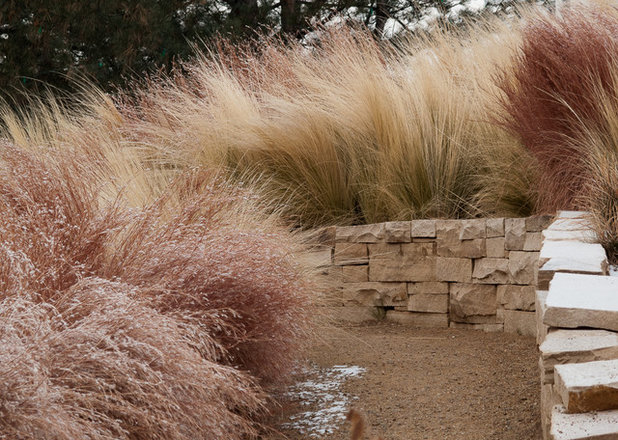
Le jardinet
3. Use grasses to create mystery. I’m naturally inquisitive, so it isn’t surprising that as soon as I saw this path, I wanted to see what was around the corner. However, that wasn’t enough — I also wanted to see what was behind the grasses themselves.
Tip: Use a mass planting of grasses to create a low hedge, either planted in the ground or in raised planters for additional height. A single grass species would work well, but the blend of colors used here is very appealing also.
Line both sides of a winding path with grasses to at least partially obscure the final destination. You could even take this a step further and design a maze with grasses.
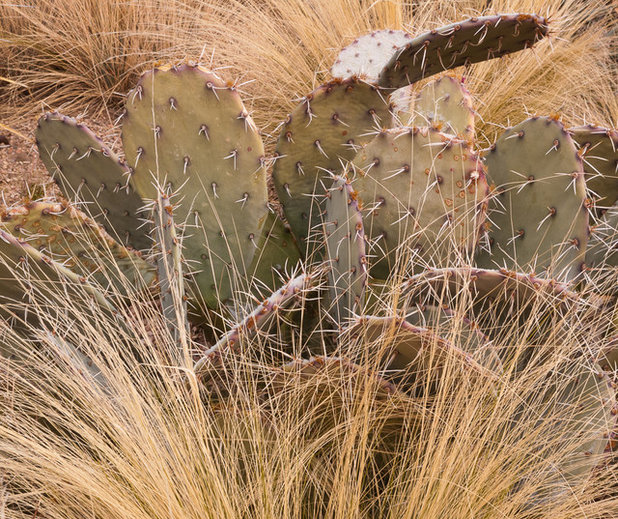
Le jardinet
4. Use grasses for texture. The term “texture” in gardening refers to how a plant feels as well as how imposing a leaf is. For example, a plant may feel soft or spiky, smooth or rough. It may also be described as having a bold texture — that is, a big leaf surface, such as a hosta has — or at the opposite end of the scale, a fine, wispy texture, such as Mexican feather grass (
Stipa tenuissima, shown) has.
Garden design relies on a pleasing balance of textures, and this photograph shows the two extremes with a bold
prickly pear (
Opuntia compressa)
armored with wicked spines surrounded by the supersoft grasses.
Tip: This combination won’t work for everybody. Mexican feather grass is invasive in many states, and prickly pear cactus, although hardy in USDA zones 4 to 9, needs a dry climate. You could get a similar effect by combining the soft
coffee sedge (
Carex tenuiculmus ‘Cappucino’) with the ghostly white canes of the
ghost bramble (
Rubus cockburnianus ‘Aureus’).





